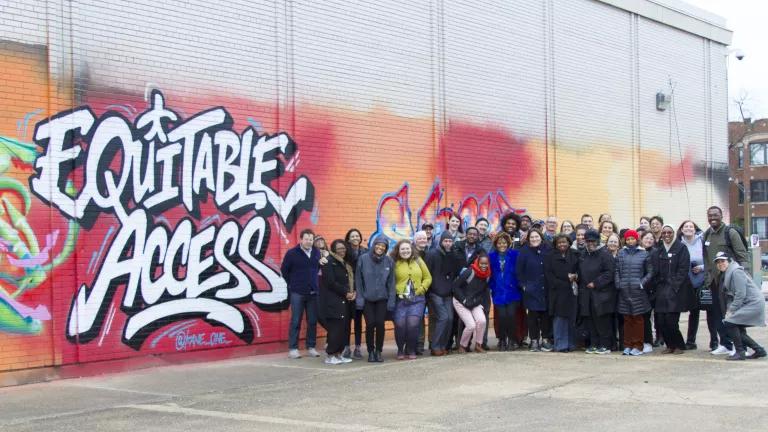What if States Turn Pavement Into Charging Stations?
What if we didn't invest Infrastructure Law funds in more pavement, but in a better future?

Installing an EV charging station
Dennis Schroeder/NREL, 49470
We both appreciated comic books while growing up, and one of us especially enjoyed “What if?,” which explored different outcomes based on the choices of characters.
We are at a “What if?” moment now with the new “Bipartisan Infrastructure Law.” What if states use the funds to build new traffic-clogged highways? Or what if they take a share of those funds and invest it in ways that will reduce our dependence on oil and help deliver a cleaner future?
As it’s Infrastructure Week, this is a good time to examine how we can turn that second “What if?” into steel-in-the-ground that helps get us off oil.
To explain how this law could play out very differently, let’s look at the two largest programs it funds— the National Highway Performance Program ($148 billion over five years) and the Surface Transportation Block Grant program ($72 billion over five years). Those funds could all be spent on more pavement, perpetuating oil and car dependence, or some could be invested in a better future.
The block grant program is explicitly designed to be versatile — and is available for a wide range of uses. In fact, it was originally created in the 1991 transportation law to encourage states to move beyond the interstate highway-building era and into investments in other improvements to our transportation system (see more on the Intermodal Surface Transportation Efficiency Act of 1991 here) and Congress has added more uses since then.
One investment category available for these programs is electric vehicle charging infrastructure. So here is the question for this blog: What if federal grantees — metropolitan planning organizations and states — use 20 percent of the funding from these two “highway” programs to build charging infrastructure?

US Department of Transportation approved EV charging signage
This would pull $44 billion dollars into charging infrastructure investments between now and 2026, massively supplementing the Infrastructure Law’s $5 billion “National Electric Vehicle Infrastructure” program.
How does this compare to the investment in charging infrastructure needed to transition our fleet entirely away from oil? Building out that charging ecosystem is no small undertaking, although the good news is that we start with an existing, ubiquitous system — our national electric grid — that we just need to plug into. And because the grid is built to accommodate the one hour in the year during which demand for electricity peaks, the system has plenty of spare capacity that we can take advantage of to charge vehicles (and doing so puts downward pressure on electric rates to the benefit of all utility customers).
Experts estimate we need about $39 billion to build a national network of public charging infrastructure for passenger vehicles, and between $65 and $135 billion for on-road charging for medium and heavy-duty vehicles by 2030. To be clear, not all that needs to come from U.S. Department of Transportation. Local, state, and private sector funding will come off the sidelines as federal investments ramp up, signaling large-scale and reliable commitment to transportation electrification.
What would that future look like compared to one in which we worsen our oil addiction by just investing in more pavement? If that $44 billion that would have been pavement is used to install charging infrastructure and attract matching investments that put us on a path to zero-emission vehicles accounting for 100 percent of new vehicle sales, it would yield an enormous return—$1.2 trillion in public health benefits and $1.7 trillion in climate benefits by 2050, according to recent analysis from the American Lung Association. This future would also avoid 110,000 premature deaths, 2.78 million asthma attacks, and 13.4 million lost work days. In that world, we’d look around and see healthier family and friends and fewer extreme weather events due to reduced pollution spewed by tailpipes.
Getting off oil would also provide consumers savings they could bank on. Electricity prices are more stable than gasoline, and have been at about the equivalent of a dollar a gallon gasoline for decades. It’s time to get off the crazy oil-price rollercoaster ride and unshackle us from the whims of petro-dictators.

So, by making the right investments now in charging infrastructure and clean mobility options, we can see: less traffic, lower costs for consumers, cleaner air for everyone and a climate that will be protected for our grandchildren.
In short, with the right policies and investments we can tackle climate change, reduce our dependence on oil, and save money. Let’s make smart choices today, so twenty years from now, we won’t have to ask, “What if we hadn’t doubled down on oil dependence?”



